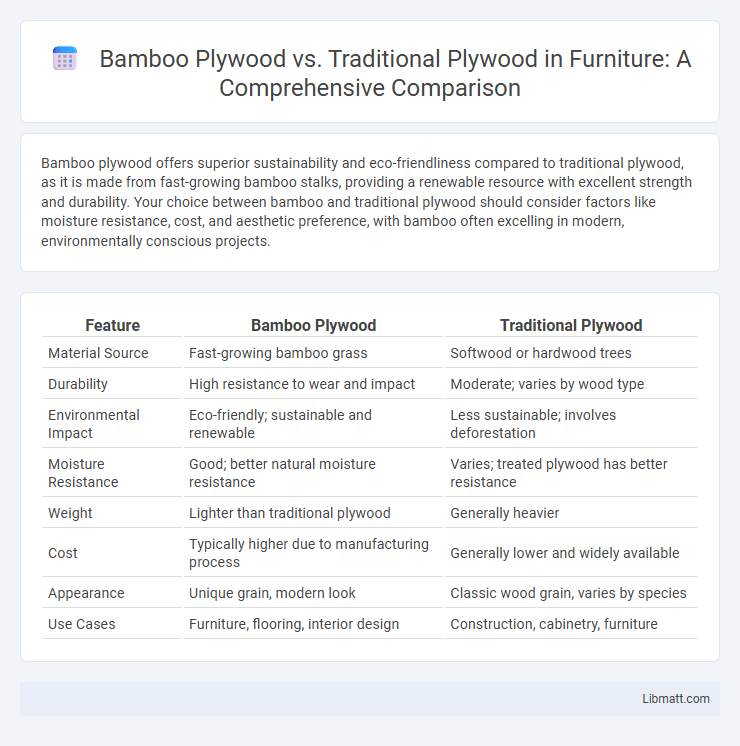Bamboo plywood offers superior sustainability and eco-friendliness compared to traditional plywood, as it is made from fast-growing bamboo stalks, providing a renewable resource with excellent strength and durability. Your choice between bamboo and traditional plywood should consider factors like moisture resistance, cost, and aesthetic preference, with bamboo often excelling in modern, environmentally conscious projects.
Table of Comparison
| Feature | Bamboo Plywood | Traditional Plywood |
|---|---|---|
| Material Source | Fast-growing bamboo grass | Softwood or hardwood trees |
| Durability | High resistance to wear and impact | Moderate; varies by wood type |
| Environmental Impact | Eco-friendly; sustainable and renewable | Less sustainable; involves deforestation |
| Moisture Resistance | Good; better natural moisture resistance | Varies; treated plywood has better resistance |
| Weight | Lighter than traditional plywood | Generally heavier |
| Cost | Typically higher due to manufacturing process | Generally lower and widely available |
| Appearance | Unique grain, modern look | Classic wood grain, varies by species |
| Use Cases | Furniture, flooring, interior design | Construction, cabinetry, furniture |
Introduction to Bamboo Plywood and Traditional Plywood
Bamboo plywood consists of thin layers of bamboo veneer laminated together, offering superior strength, durability, and eco-friendliness compared to traditional plywood made from hardwood or softwood layers. Traditional plywood features alternating grain patterns in wood veneers to enhance stability and reduce warping, typically sourced from trees like pine, birch, or oak. Bamboo plywood's rapid growth rate and sustainable harvesting make it a preferred choice for environmentally conscious construction and furniture projects.
Composition and Manufacturing Processes
Bamboo plywood consists of laminated bamboo strips, bonded together using eco-friendly adhesives, offering a sustainable alternative to traditional plywood made from hardwood or softwood veneers glued in multiple layers. The manufacturing process of bamboo plywood involves compressing bamboo strips under high pressure and heat, resulting in a dense, durable panel with consistent grain patterns, whereas traditional plywood is crafted by rotary cutting or slicing logs into thin veneers followed by layering them with alternating grain directions. Understanding these composition and manufacturing differences can help you choose the best plywood for strength, sustainability, and aesthetic appeal in your projects.
Environmental Impact and Sustainability
Bamboo plywood offers a significantly lower environmental impact compared to traditional plywood due to its rapid growth rate and renewability, allowing for faster replanting cycles and reduced deforestation. It is highly sustainable, as bamboo absorbs more CO2 and produces more oxygen than most hardwood trees, contributing to a healthier ecosystem. Your choice of bamboo plywood supports sustainable forestry practices and reduces the carbon footprint associated with conventional plywood production.
Durability and Structural Strength
Bamboo plywood offers superior durability and structural strength compared to traditional plywood due to its dense fiber composition and natural resilience. Its cross-laminated layers provide enhanced resistance to warping, cracking, and moisture damage, making it a reliable choice for high-stress applications. Choosing bamboo plywood ensures your project benefits from a sustainable material that maintains integrity under heavy loads and long-term use.
Appearance and Aesthetic Qualities
Bamboo plywood features a distinctive linear grain pattern and a warm, natural color that offers a modern, eco-friendly aesthetic compared to the varied grain and color tones of traditional plywood. Its smooth, uniform surface enhances the visual appeal in contemporary designs, providing both durability and style. Your choice of bamboo plywood can create a unique and attractive finish that stands out in cabinetry, flooring, and furniture applications.
Cost Comparison and Affordability
Bamboo plywood typically offers a competitive cost advantage over traditional plywood due to its rapid growth cycle and sustainable harvesting, often resulting in lower material prices. While the initial investment in bamboo plywood may be slightly higher in some regions, its durability and resistance to moisture can reduce long-term maintenance expenses, enhancing overall affordability. Your choice between bamboo and traditional plywood should consider not only upfront cost but also lifecycle value to maximize budget efficiency.
Workability and Ease of Use
Bamboo plywood offers superior workability compared to traditional plywood due to its uniform grain and consistent density, allowing for cleaner cuts and less splintering. Its lightweight nature makes handling and installation easier, reducing fatigue during extended projects. Your woodworking experience will benefit from bamboo plywood's smooth surface, which requires less sanding and holds fasteners securely.
Applications and Best Uses
Bamboo plywood is ideal for eco-friendly furniture, flooring, and cabinetry due to its durability, moisture resistance, and sustainable growth rate. Traditional plywood suits structural applications like roofing, subflooring, and wall sheathing, benefiting from its strength, versatility, and cost-effectiveness. Both materials excel in different environments, with bamboo favored for modern interior design and traditional plywood preferred in heavy-duty construction projects.
Maintenance and Longevity
Bamboo plywood offers superior resistance to moisture, pests, and warping compared to traditional plywood, reducing maintenance frequency and costs. Its natural durability and tight grain structure contribute to a longer lifespan, often outperforming conventional plywood in humid or high-traffic environments. Regular sealing and proper care further enhance bamboo plywood's longevity, making it a sustainable and resilient alternative for various applications.
Conclusion: Choosing the Right Plywood for Your Project
Bamboo plywood offers superior sustainability and durability compared to traditional plywood, making it ideal for eco-conscious projects requiring strength and moisture resistance. Traditional plywood remains a cost-effective choice with widespread availability and ease of customization for general construction and furniture applications. Selecting the right plywood depends on balancing environmental impact, performance needs, and budget constraints specific to your project requirements.
bamboo plywood vs traditional plywood Infographic

 libmatt.com
libmatt.com